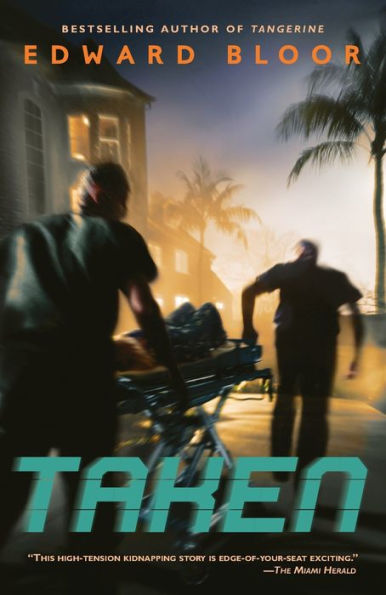

Paperback
-
PICK UP IN STORECheck Availability at Nearby Stores
Available within 2 business hours
Related collections and offers
Overview
By 2035 the rich have gotten richer, the poor have gotten poorer, and kidnapping has become a major growth industry in the United States. The children of privilege live in secure, gated communities and are escorted to and from school by armed guards.
But the security around Charity Meyers has broken down. On New Year’s morning she wakes and finds herself alone, strapped to a stretcher, in an ambulance that’s not moving. If this were a normal kidnapping, Charity would be fine. But as the hours of her imprisonment tick by, Charity realizes there is nothing normal about what’s going on. No training could prepare her for what her kidnappers really want . . . and worse, for who they turn out to be.

Product Details
| ISBN-13: | 9780440421283 |
|---|---|
| Publisher: | Random House Children's Books |
| Publication date: | 12/08/2009 |
| Pages: | 256 |
| Sales rank: | 999,132 |
| Product dimensions: | 5.22(w) x 8.02(h) x 0.56(d) |
| Age Range: | 12 Years |
About the Author
Read an Excerpt
Once you’ve been taken, you usually have twenty-four hours left to live. By my reckoning, that meant I had about twelve hours remaining. The blue numerals on my vidscreen showed the time, 11:31, and the date, 01-01-36. From where I was lying, the blue glow of the vidscreen provided the only color in the room. If it was a room. Other than the screen, all I could see were white walls. All I could hear was a low thrumming, like an engine.
Ever since I’d come to my senses, though, I’d felt strangely calm. Not like a sedated calm, either, although I had definitely been sedated. No, it was more of a logical calm. I was trying not to panic; trying to think things through. I was not in this room of my own free will. Therefore, I was a prisoner. Logically, then, I must have been “taken,” the popular euphemism for “kidnapped.”
If you lived in The Highlands, like I did, then you were an expert on kidnapping. I even wrote a paper on the subject. It was filed right there on my vidscreen, along with the other papers I had written last term: “The World Credit Crash,” “Metric at Midnight, 2031,” and “The Kidnapping Industry.”
I tried to sit up, but I couldn’t. I had a strap tied around my waist, holding me to the bed. Or was it a stretcher? Yes, I remembered. It was a stretcher. I could move my arms, at least. I could reach over and press MENU. The screen was still active, but it looked like all input and output functions had been disabled. Not surprising, if I had been taken. My own files, though, were still accessible to me. I located my recent term papers and clicked on the pertinent one. Here is part of what it said:
The Kidnapping Industry,by Charity Meyers
Mrs.Veck, Grades 7—8
August 30, 2035
Kidnapping has become a major growth industry. Like any industry, though, it is subject to the rules of the marketplace. Rule number one is that the industry must satisfy the needs of its customers.That is, if parents follow the instructions and deliver the currency to the kidnappers, the kidnappers must deliver the taken child back to the parents. If the kidnappers do not fulfill their part of the bargain, then future parents will hear about it, and they will refuse to pay. The trust between the kidnappers and the parents will have broken down. The kidnapping industry today in most areas of the United States usually operates on a twentyfour- hour cycle (although a twelve-hour cycle is not uncommon in areas outside of the United States). In the majority (85%) of cases, the parents deliver the currency and the kidnappers return the child within the twenty-four-hour period. Kidnappers’ demands usually include a warning to parents not to contact the authorities. It is hard to estimate, therefore, how many parents have actually received ransom instructions and obeyed them to the letter. Professional kidnappers always include a Plan B in their instructions, describing a second meeting place in case the first falls through. In a minority (12%) of cases, unprofessional crews have murdered their victims right away and continued the ransom process dishonestly. Several related industries have emerged as a result of the rise in kidnappings. For example, special security companies now track victims who have not been returned but who are thought to be still alive. These companies can gain access to FBI data. Unlike the FBI, however, these companies are willing to search for taken children in unsecured areas of the United States and in foreign countries.
The paper went on from there to describe common aftereffects on taken children and to cite many alarming statistics about kidnapping, supplied by the stateofflorida.gov and TheHighlands.biz content sites. Cases of reported kidnappings increased by 22 percent in the last three years. However, estimates are that unreported kidnappings increased as much as 800 percent in the same time period. The statistics only reinforced what I already knew. It’s what every kid knew: if kidnappers identify your parents as people with a lot of currency in their home vault–dollars, euros, pesos, yuan–then you are a target. And if you don’t get returned right away, there’s not much the authorities can do about it. They are only willing to track you so far. Even now, there are parts of Florida and Texas that are beyond the reach of regular police forces. And from there, who knows? The Caribbean, Mexico, South America? Once you are gone to one of those places, you stay gone.
